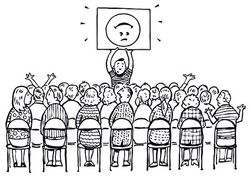
A method that is applicable to large meetings is to use some kind of audience response equipment if you quickly want to get an idea of what a group of people think about one or several issues.
Make it very clear in the invitation what the idea of the meeting is. Be quick with feedback from the meeting and inform on the web or through other information channels. Be careful to formulate the questions so they can be easily answered, and maybe you can try the questions on a few people beforehand. The method gives an immediate response to the questions asked on a large screen, text messages also roll up as they are received. Everyone has the same chance of expressing their views – it is not possible for a few “smooth-spoken ones” to hijack the meeting. You can manage to ask many questions in a relatively short time, and the answers are anonymous. As a participant in the meeting you can quickly grasp if there are more people sharing your opinion, or if they express other opinions. Participants often perceive the method as positive, since you get a first-hand picture of what people think on various issues. Since you are going to rent equipment, you must dimension premises and estimate the number of participants to the best of your ability beforehand. Time is required for preparations, booking premises and equipment, invitations, formulating questions, etc. The actual performance will not take more time than an ordinary meeting. There are variations in how advanced the equipment is, which affects the cost. In a number of municipalities and regional boards the council halls are equipped with stationary voting equipment that can also be used for putting questions to citizens. If you consider investing in such equipment, a mobile set could be a good alternative. In that case, the audience response equipment could be used in many places. It could also be a good idea to coordinate any investments with one or two adjacent municipalities. If you buy compatible equipment, you can borrow it from each other in case of large meetings.
Make it very clear in the invitation what the idea of the meeting is. Be quick with feedback from the meeting and inform on the web or through other information channels. Be careful to formulate the questions so they can be easily answered, and maybe you can try the questions on a few people beforehand. The method gives an immediate response to the questions asked on a large screen, text messages also roll up as they are received. Everyone has the same chance of expressing their views – it is not possible for a few “smooth-spoken ones” to hijack the meeting. You can manage to ask many questions in a relatively short time, and the answers are anonymous. As a participant in the meeting you can quickly grasp if there are more people sharing your opinion, or if they express other opinions. Participants often perceive the method as positive, since you get a first-hand picture of what people think on various issues. Since you are going to rent equipment, you must dimension premises and estimate the number of participants to the best of your ability beforehand. Time is required for preparations, booking premises and equipment, invitations, formulating questions, etc. The actual performance will not take more time than an ordinary meeting. There are variations in how advanced the equipment is, which affects the cost. In a number of municipalities and regional boards the council halls are equipped with stationary voting equipment that can also be used for putting questions to citizens. If you consider investing in such equipment, a mobile set could be a good alternative. In that case, the audience response equipment could be used in many places. It could also be a good idea to coordinate any investments with one or two adjacent municipalities. If you buy compatible equipment, you can borrow it from each other in case of large meetings.
 RSS Feed
RSS Feed
